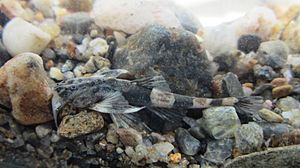Dupouyichthys sapito facts for kids
Quick facts for kids Dupouyichthys sapito |
|
|---|---|
 |
|
| Conservation status | |
|
Not evaluated (IUCN 3.1)
|
|
| Scientific classification | |
| Kingdom: | |
| Phylum: | |
| Class: | |
| Order: | |
| Family: |
Aspredinidae
|
| Subfamily: |
Hoplomyzontinae
|
| Genus: |
Dupouyichthys
L. P. Schultz, 1944
|
| Species: |
D. sapito
|
| Binomial name | |
| Dupouyichthys sapito L. P. Schultz, 1944
|
|
Dupouyichthys sapito is a special type of catfish that looks a bit like a banjo! It's the only known species in its group, called Dupouyichthys. This small fish lives in rivers and lakes in South America.
Meet the Banjo Catfish
The Dupouyichthys sapito is a unique kind of banjo catfish. It's the only species in its entire genus (a group of closely related animals) called Dupouyichthys. This interesting fish was first described by a scientist named Leonard Peter Schultz in 1944.
Home Sweet Home: Rivers of South America
This small catfish is found in specific parts of Colombia and Venezuela. It mostly lives in the Magdalena River basin and the area around Lake Maracaibo. These fish like to hang out near the banks of rivers where there are lots of plants. They prefer places with vegetation, which helps them hide and find food.
Tiny but Tough: Special Features
The Dupouyichthys sapito is quite small. It grows to about 27 millimeters (just over an inch) long. This measurement is called "standard length" (SL), which means it's measured from the tip of its nose to the base of its tail.
This catfish is also "armored." This means it has special bony plates on its body, which act like a protective suit. One unique thing about D. sapito is that it has only one set of paired plates near its anal fin. Its skull also has more developed bony patterns compared to its close relatives. These features help scientists tell it apart from other banjo catfishes.

